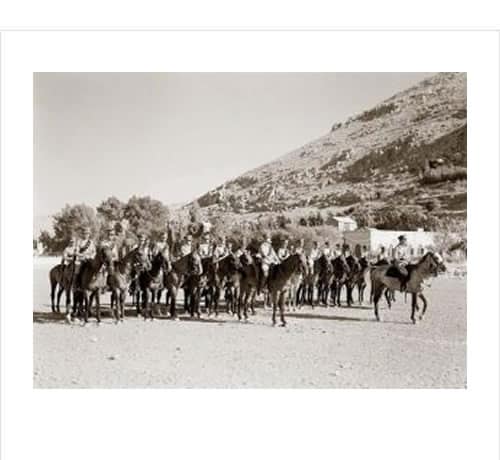Memoirs of a young officer in the 8th King’s Royal Irish Hussars.
Swords were drawn, squadrons inline riding knee to knee, sword signals, trumpet calls for troops right wheel, left wheel, right about the wheel, we knew them all and sang little ditties to them.
The jingle of harness, the thunder of hooves, surely nothing could be more exciting. Stable smells, neighing, whinnying and the care and affection for one’s own horse on which so much depended. I’m happy to have had the experience.
In a few years, they were all to go and life would never be the same.
Joining the Regiment at Aldershot in 1932 I was soon being put through my paces on the square under the Drill SSM Tommy Hampton and the RSM Mr O’Shaugnessy or ‘Shaugho’ as he was affectionately known. He was proud of his recruits and was determined to turn them out as good Irish Hussars.
The Adjutant at this time was Captain T.B.A. Evans-Lombe, who later was to be known as the inventor of the sun compass.
Later in the year, the Regiment rode from Aldershot to Hounslow where we would stay for twelve months and it was here that our training in horsemanship would begin.
Chris Vernon-Miller was the Riding Master, assisted by the SSM RI Bob Duncan. Each morning we would ride out onto Hounslow Heath and into the old World War One Flying Corps Hangar which was used as a riding school.
As far as I remember it was here, whilst learning to jump, that I ‘Bit the dust’ for the first time. To give the recruits confidence they were told to shout their names and from where they came as they jumped the fence. Of course, we were riding bareback and I promptly shouted out my name, but before I could give my home town I fell off and got a mouth full of peat.
On short leave, before passing out of riding school I went up to London to see the Lord Mayor’s Show and how proud I felt when telling my companion that the cavalry in the procession and the mounted band in full dress was my Regiment.
Before leaving England the Regimental Association held their OCA Dinner at the Connaught Rooms in London and most of the recruits attended. It was like joining a great family party.
In December 1933 on the voyage out to Egypt on HMS Nevassa I can still see Charlie Hedley reciting ‘Sam pick up thy musket’ and Lt Guy Lowther, dressed as a Fairy Queen descending the rigging in the ship-board Christmas pantomime.
On arrival in Cairo training continued until we felt like real cavalrymen, having been taught to fight with the sword and rifle and with troop, squadron and regimental training.
Regular regimental and brigade exercises took place both in the desert and in the Nile Delta.
On the left-hand side of the saddle would be your sword and the shoe case and on the right the rifle bucket holding a 303. Attached to the front arch would be a rolled groundsheet and to the rear a blanket and a full nose bag for your horse. A rope would be around the horses’ neck. Communication was by sword and hand signals, mounted messengers, semaphore and helio.
At night you slept on the ground behind your shackled horse and in the horse lines.
On one occasion the Regiment was watered from the air by the old Vickers Valencia aircraft when out in the desert northwest of Cairo.
On one particular Command exercise, the Regiment rode about 150 miles in 36 hours and was congratulated on not having a single sore back reported.
At last, on Armistice Day 1935, 242 years after the formation of the 8th King’s Royal Irish Hussars at Enniskillen in 1693, the Regiment and the mounted band was drawn up in the desert outside Cairo for inspection by the GOC-in-C Lt General Sir George Weir. After inspection, the Regiment trotted past and then wheeled and galloped past for the last
time.
Mechanisation and war followed but that is another part of the Regiment’s history.
PRISTINAE VIRTUTIS MEMORES


